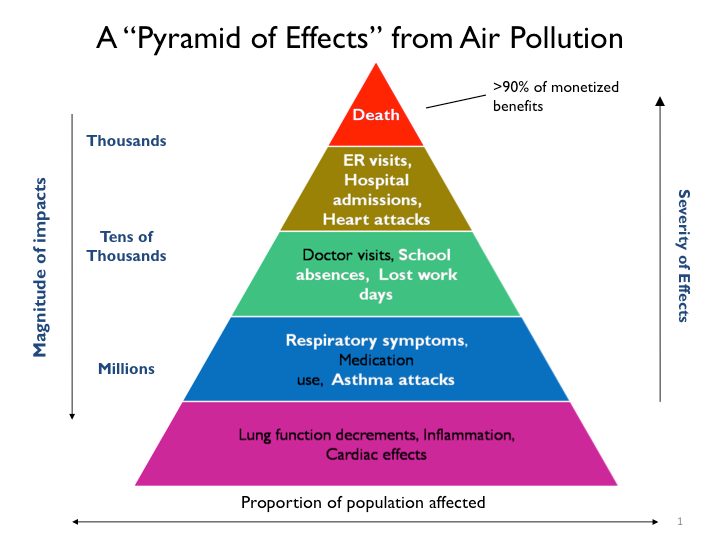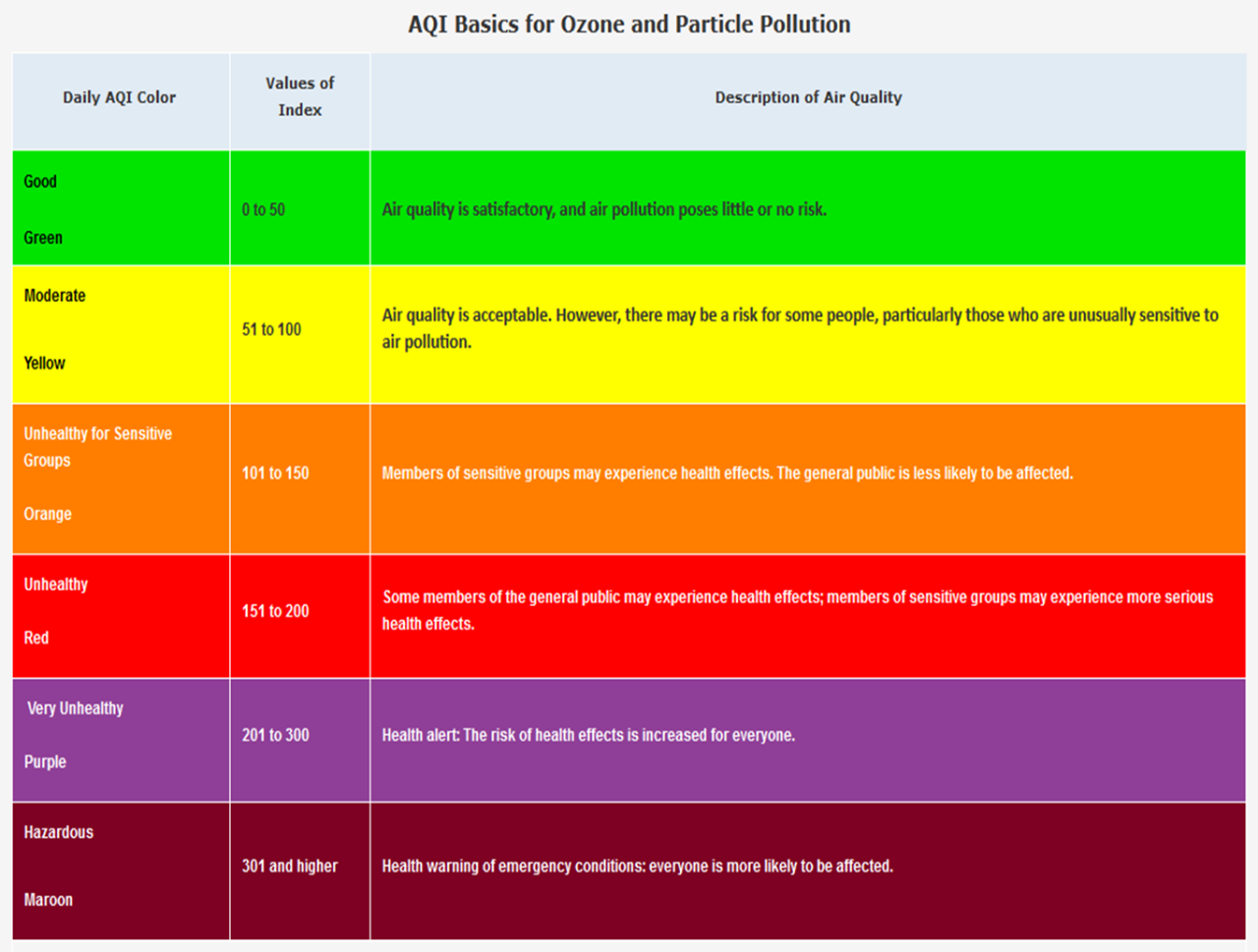Air Quality & Health

Why is air quality important to health?
What are adverse health effects of air pollution?
How to protect your respiratory health?
What are common outdoor air pollutants?
Why is ground-level ozone a health concern?
Why is particulate pollution a health concern?
What are common indoor air pollutants?
What is the Air Quality Index?
Who tests air quality?
Government partners
Additional resources
Helpful documents
Why is air quality important to health?
Air pollution reduces air quality and thus is a major risk to health. Air pollution causes to a number of health concerns such as asthma, allergies, lung disease, anxiety and depression. Babies, young children, teenagers, the elderly, pregnant women and people with preexisting respiratory medical conditions are especially vulnerable to air pollution.
The types and amount of air pollution you may breathe will vary by your location, the time of day, the temperature and the weather.
Some sources of air pollution are natural such as smoke from wildfires, pollen from plants, dander from pets, or spores from molds. Many sources of air pollution are of our own making such as air pollution from burning coal, driving cars and trucks, and incinerating garbage. We even pollute the air inside our homes we when smoke tobacco, burn wood or use candles.
When public health is protected by good air quality there are numerous economic co-benefits. Beyond everyone’s desire to be able to breathe easy, these economic co-benefits support efforts to improve air quality. Good air quality reduces healthcare bills for heart attack, stroke, asthma, lung cancer and respiratory illness hospitalizations or even premature deaths.
What are adverse health effects of air pollution?
· Asthma attacks
· Wheezing and cough
· Shortness of breath
· Lung tissue swelling
· Lung cancer
· Cardiovascular harm
· Susceptibility to infections
· Premature death
How to protect your respiratory health?
1. Be air aware. Learn about the color codes of the Air Quality Index to know when outdoor air quality may be poor.
2. Quit smoking. Too many Tennesseans use tobacco products. Use the TN Tobacco Quitline for help to quit smoking or chewing tobacco.
3. Protect yourself while driving. When stuck in heavy traffic, recirculate the air in your car to avoid breathing vehicle exhaust.
4. Avoid exposure to air pollutants. Avoid cigarette smoke, wood smoke, vehicle exhaust, dust and other airborne particles when possible.
The Environmental Protection Agency illustrates the adverse health effects of air pollution using this pyramid. The base of the pyramid illustrates the millions of people who have breathing difficulties due to air pollution. The top of the pyramid represents the thousands of people who die each year from lung cancer or other respiratory illnesses cauesed by air pollution.

What are common outdoor air pollutants?
Common outdoor air pollutants include byproducts from smokestack or automobile emissions like particulate matter (PM), nitrogen dioxide (NO2), sulfur dioxide (SO2) and ozone (O3). Other outdoor air pollutants are allergens like pollen and mold. There has been a lot of study about adverse health effects of ground-level ozone and particulate pollution.
Why is ground-level ozone a health concern?
Ground-level ozone is an air pollutant. The ozone layer in Earth’s upper atmosphere is good. Ozone in the lower atmosphere close to ground in the air that we breathe can be a health hazard. Ozone can be created when other air pollutants react with sunlight. Common symptoms of ozone exposure are coughing and pain when taking a deep breath, lung and throat irritation, or wheezing and trouble breathing. Ozone effects are often more severe when breathing deeply such as when doing strenuous activities or exercising. Ozone is more common in warmer months; unfortunately the same months of the year when people tend to be more active outdoors. For people with asthma, bronchitis, emphysema or other respiratory illness, symptoms of exposure to ozone in the air are often worse and can lead to more medical emergencies.
Why is particulate pollution a health concern?
Particulate pollution includes dust, dirt, soot, smoke or drops of liquid. This form of air pollution is often called particulate matter or PM for short. Some particles are big enough or dark enough to see in the air while many particles are too small or too light to see with your eyes. The bigger particles are often called PM10 and the smaller particles PM2.5. The smaller particles are considered to be more dangerous as these tiny PM2.5 particles can get farther into your lungs. Common symptoms of exposure to particle pollution are eye irritation, lung and throat irritation, trouble breathing, lung cancer, or problems with babies at birth like low birth weight. For people with heart disease, particle pollution can cause serious health problems like a heart attack.
What are common indoor air pollutants?
Common indoor air pollutants include tobacco smoke, fumes from paints and solvents, radon, carbon monoxide, formaldehyde, animal hair and dander, molds, bacteria, pollen and combustion gases. Indoor air pollutants can be especially harmful to people with asthma, emphysema, COPD or other breathing difficulties. Good indoor air quality is important to maintaining a Healthy Home.
What is the Air Quality Index?
The Air Quality Index is a reporting system for quickly sharing the amount of air pollution forecast for an area. The AQI uses a color system to make it easy for people to quickly determine if air quality is reaching levels that might be unhealthy for them to be working, playing or exercising outdoors.

EPA’s AirNow website at www.airnow.gov/#TN is a great website to obtain information about the air quality in your community. This website gives information about Tennessee as well as other major cities across the United States.
Who tests air quality?
The Tennessee Department of Environment and Conservation’s Division of Air Pollution directly serves 91 counties within the state by monitoring industries, conducting air pollution source visits, testing and monitoring air at the various stations set up across the state and other tasks.
TDEC has numerous monitors stationed across the state to gather outdoor air quality data. The yellow stars show particulate matter monitors and the red stars show ozone monitors. TDEC's Air Quality Monitoring plans and maps can be found at TDEC's Air Quality Monitoring site.
The Division of Air Pollution Control also oversees and assists in the actions of local air pollution control programs in Davidson, Hamilton, Knox and Shelby counties. If you live in Davidson, Hamilton, Knox or Shelby counties you must contact these local air programs for further air testing information.

Government partners
Centers for Disease Control and Prevention (CDC)
Learn about Air Quality
www.cdc.gov/air/default.htm
U.S. Environmental Protection Agency (EPA)
More to learn about Air Quality
www.epa.gov/learn-issues/learn-about-air
Radon
www.epa.gov/radon
Indoor Air Quality Tools for Schools Action Kit
www.epa.gov/iaq-schools/indoor-air-quality-tools-schools-action-kit
Development and Implementation of a School Environmental Health Program
www.epa.gov/schools/developing-successful-state-environmental-health-program-schools
Tennessee Department of Environment and Conservation (TDEC)
Air Pollution Control (APC)
Tennessee Department of Transportation (TDOT)
Congestion Mitigation and Air Quality Improvement (CMAQ)
www.tn.gov/tdot/long-range-planning-home/air-quality-planning/cmaq.html
Additional resources
American Lung Association
Tennessee
www.lung.org/about-us/local-associations/tennessee.html
Tennessee Valley Authority (TVA)
Air Quality
www.tva.com/Environment/Environmental-Stewardship/Air-Quality
Minnesota Pollution Control Agency
Air quality and you: Health effects of air pollution
www.pca.state.mn.us/air/air-quality-and-you-health-effects-air-pollution
Helpful documents